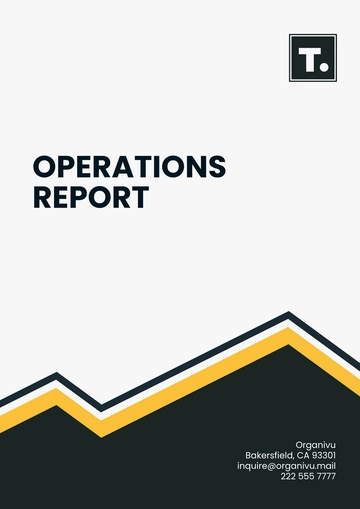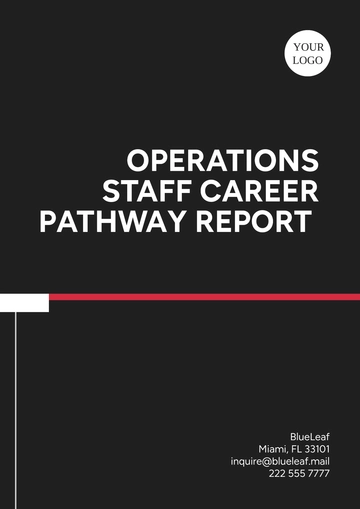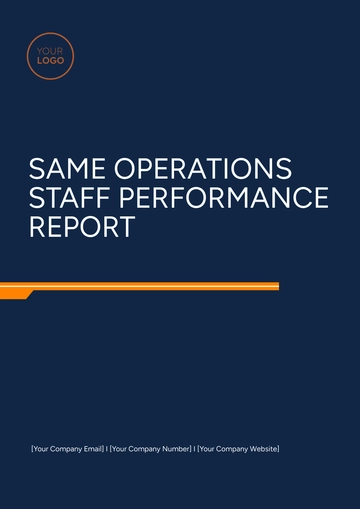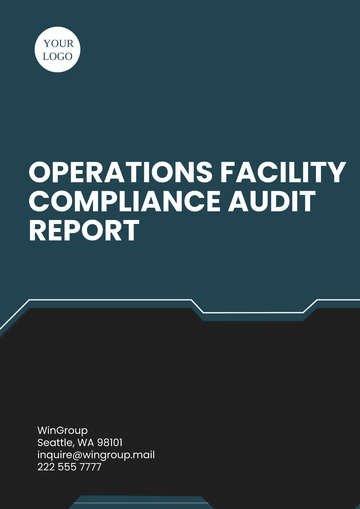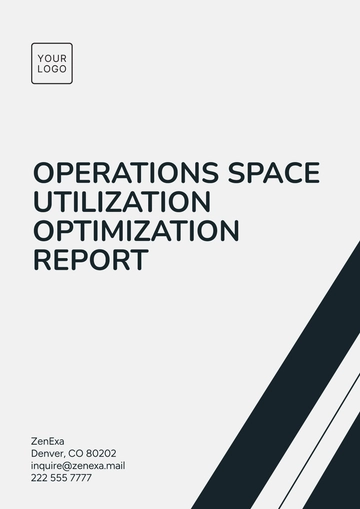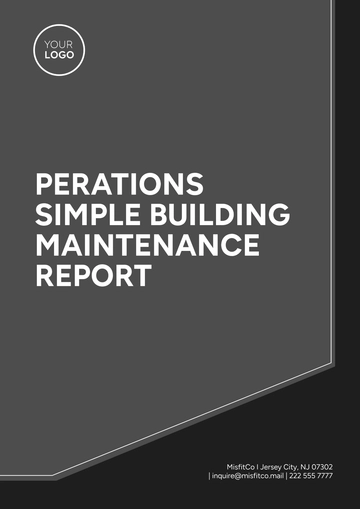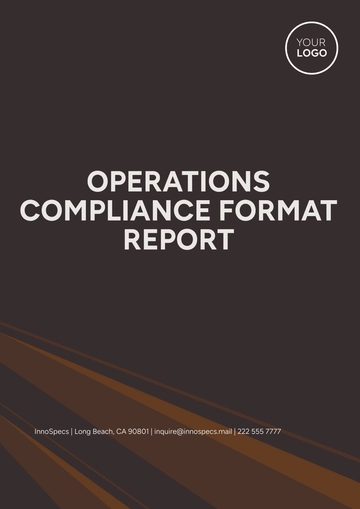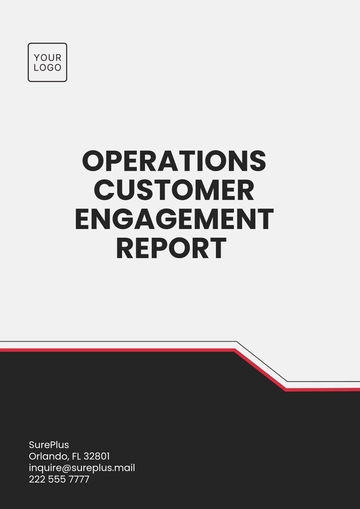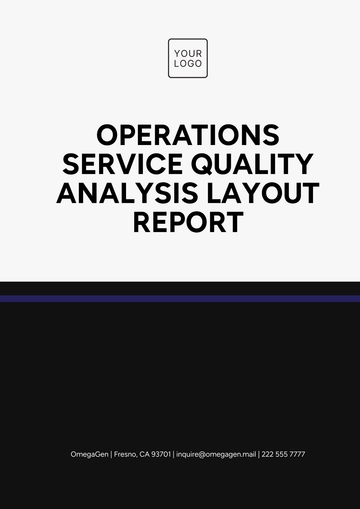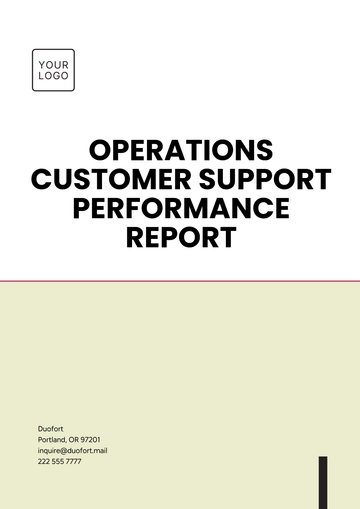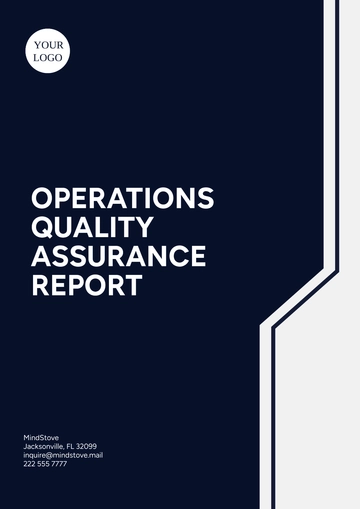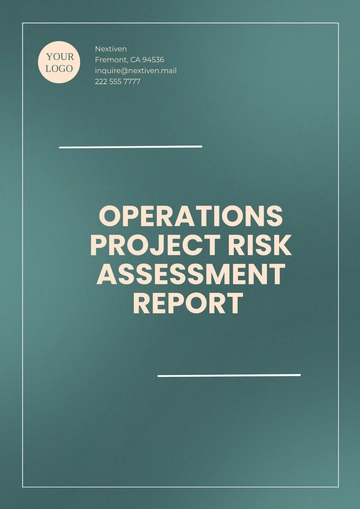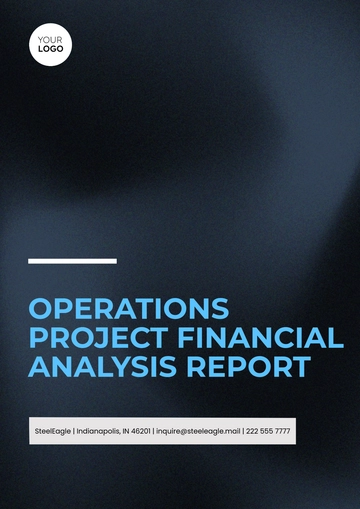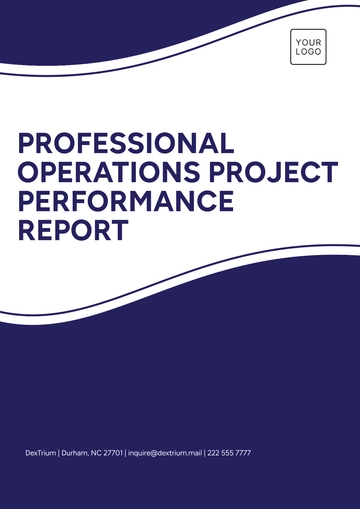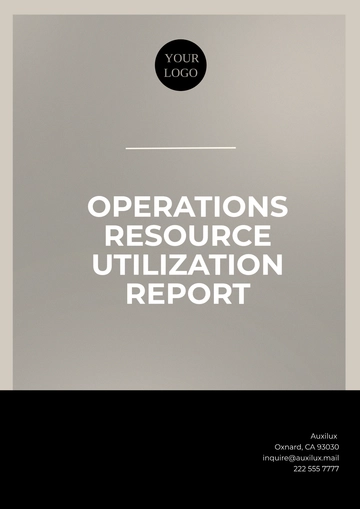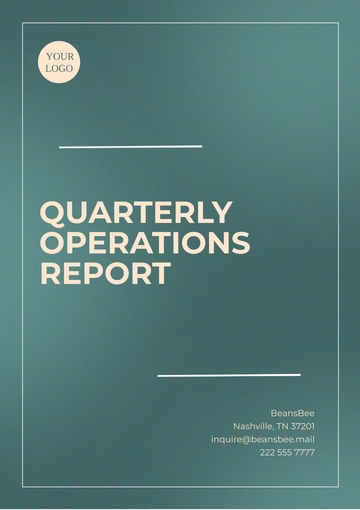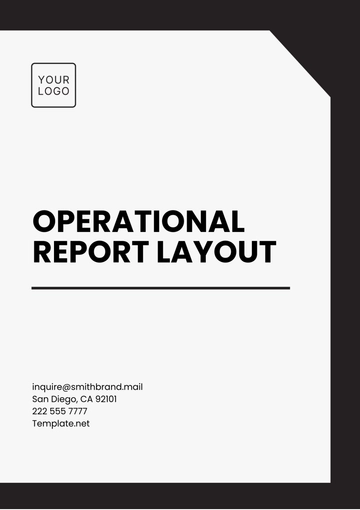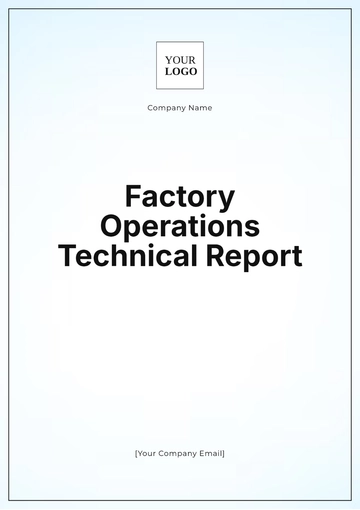Free Operations Space Utilization Optimization Report
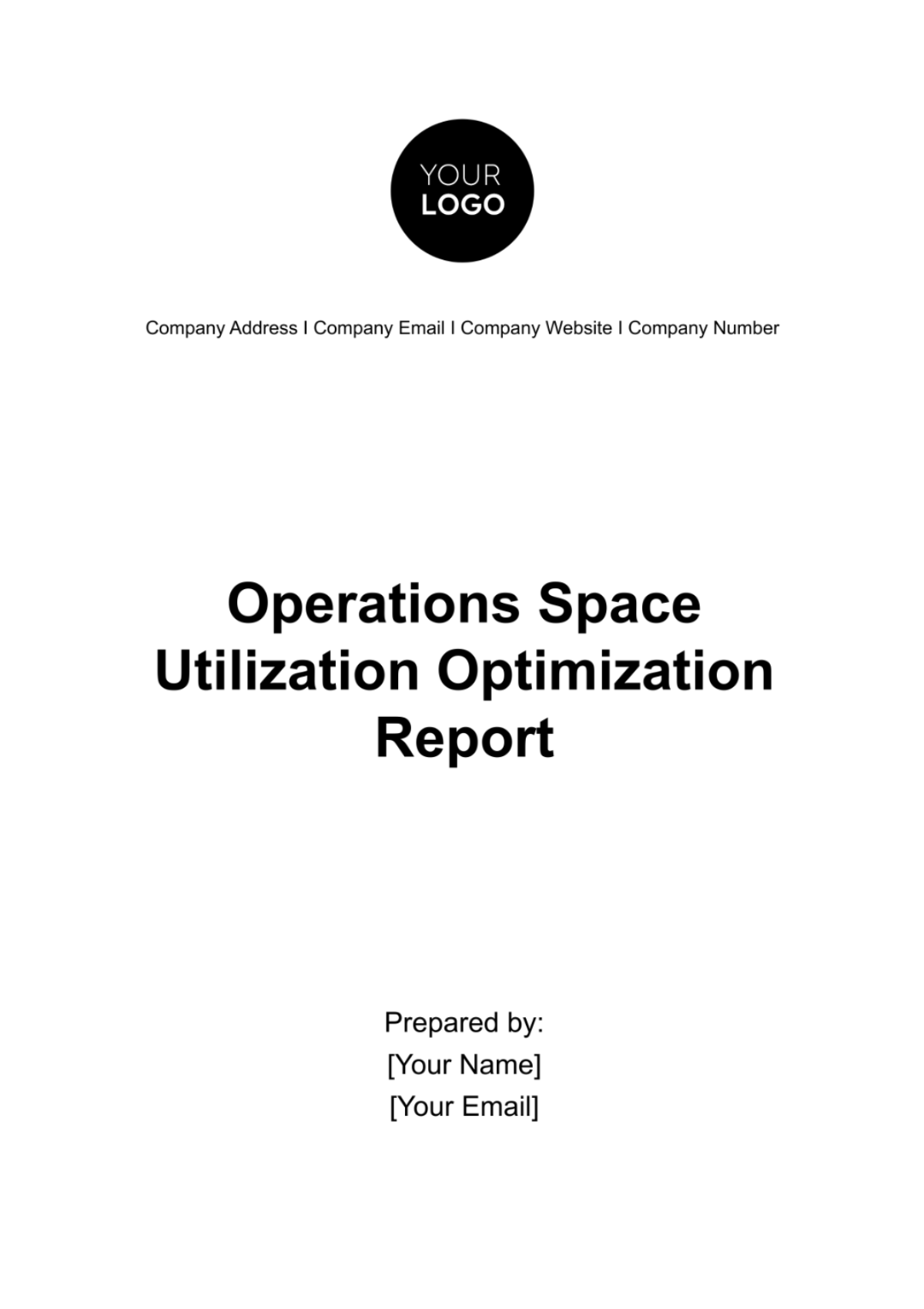
[Your Company Name]
[Your Company Address]
I. Executive Summary
This report presents a comprehensive analysis of space utilization within [Your Company Name], aiming to optimize operational efficiency and reduce costs. Analysis of peak-hour occupancy rates reveals that office spaces maintain a utilization rate of 75%, while meeting rooms exhibit a lower occupancy at 60%. Workstations, however, are highly utilized, with a rate of 90%. Key findings suggest a need for reconfiguring meeting room layouts and implementing a proactive maintenance schedule for critical equipment. By addressing these areas, the facility can enhance productivity, improve employee satisfaction, and potentially realize cost savings.
II. Introduction
A. Background
[Your Company Name] operates as a bustling distribution center for automotive parts, accommodating a workforce of over 300 employees across multiple shifts. The efficient utilization of space is vital to ensure smooth operations and timely delivery of products to customers.
B. Purpose and Scope
This report aims to evaluate the current utilization of space within the facility and identify opportunities for optimization. Through an in-depth analysis of occupancy rates, equipment usage, and workflow efficiency, the goal is to provide actionable recommendations to enhance operational effectiveness and maximize resource utilization.
III. Methodology
A. Data Collection
Data collection involved a combination of automated sensors, manual observations, and employee surveys conducted over two weeks. Occupancy rates were recorded hourly, and equipment usage was monitored in real time. Additionally, interviews were conducted with department heads to gain qualitative insights into workflow challenges.
B. Data Analysis
The collected data was analyzed using advanced statistical techniques and visualization tools. This included generating heatmaps to visualize space utilization patterns and identifying trends in equipment usage. The analysis provided valuable insights into areas of inefficiency and opportunities for improvement.
IV. Current Space Utilization Analysis
Area | Area Size (sq ft) | Occupancy Rate (%) |
|---|---|---|
Office Spaces | 10,000 | 75 |
Meeting Rooms | 2,000 | 60 |
Production Floor | 70,000 | 85 |
Breakrooms | 3,000 | 50 |
A. Facility Layout
The facility comprises warehouse space, office areas, loading docks, and breakrooms spread across a 100,000-square-foot area. Each area serves a specific function in the facility's operations.
B. Occupancy Rates
During peak hours, office spaces maintained an average occupancy rate of 75%, while breakrooms saw a lower utilization rate of 50%. Warehouse areas exhibited varying occupancy rates depending on the time of day and the nature of ongoing operations.
C. Equipment Usage
Key equipment, such as forklifts and conveyor systems, operated at high utilization rates, with minimal downtime observed during peak hours. However, certain equipment, such as packaging machines, experienced intermittent issues, leading to brief periods of downtime.
D. Workflow Efficiency
Observations revealed bottlenecks in the loading and unloading processes, particularly during peak shipping hours. These bottlenecks resulted in congestion and delays in product movement, impacting overall efficiency.
V. Key Findings
A. Underutilized Breakrooms
Despite the provision of ample space and amenities, breakrooms exhibit lower-than-expected occupancy rates, suggesting a potential mismatch between the current layout and employee preferences. This discrepancy could impact employee morale and well-being, as breakrooms serve as crucial spaces for relaxation and socialization during work hours. Addressing this issue may involve conducting employee surveys to understand preferences better and redesigning breakrooms to create more inviting and functional spaces that cater to the needs of employees.
B. Equipment Downtime
Intermittent issues with critical equipment, particularly packaging machines, lead to brief periods of downtime during peak operational hours. This downtime not only disrupts workflow continuity but also results in productivity losses and potential delays in order fulfillment. Identifying the root causes of these equipment failures and implementing a proactive maintenance program are critical steps in mitigating downtime and ensuring smooth operations. Additionally, investing in predictive maintenance technologies can help anticipate potential failures and address issues before they escalate, thereby minimizing disruptions and optimizing equipment uptime.
C. Loading Dock Congestion
Bottlenecks in the loading and unloading processes contribute to congestion and delays in product movement, especially during peak shipping hours. This congestion not only affects the efficiency of internal operations but also impacts customer satisfaction by potentially delaying order deliveries. Addressing loading dock congestion requires a multifaceted approach, including optimizing scheduling, streamlining processes, and potentially expanding or reconfiguring loading dock areas to accommodate increased throughput. Implementing these measures will not only improve workflow efficiency but also enhance the overall customer experience.
VI. Challenges and Bottlenecks
A. Inefficient Space Allocation
At present, how the facility is arranged and organized is not capitalizing on all the available space in the most effective manner. This is leading to several inefficiencies and a vast amount of resources are unfortunately being wasted as a result. This lack of optimization is particularly noticeable within certain areas of the facility, such as the breakrooms. These particular spaces are not being used to their full potential, an issue which indicates that a thorough reevaluation and possible redesign of the facility are required. Addressing these inefficiencies and optimally reallocating the space is a critical task that needs to be undertaken. By giving due attention to this issue and initiating the necessary changes, the facility will be able to utilize its resources in a better and more efficient way. This will lead to a significant improvement in the overall operational efficiency of the facility.
B. Equipment Reliability
Intermittent issues with critical equipment highlight the need for reliable operations to avoid downtime and financial losses. Implementing preventive and predictive maintenance programs can improve reliability by addressing potential problems early. Prioritizing equipment reliability ensures smooth, efficient operations and reduces disruptions.
VII. Recommendations for Optimization
A. Breakroom Redesign
I suggest conducting a thorough evaluation of breakroom usage, focusing on frequency, manner, and employee preferences, to guide a redesign. The data collected will inform decisions to improve the breakroom by incorporating amenities that promote relaxation, socialization, and well-being, fostering a more motivated and productive workforce. Consider underutilized spaces for potential repurposing, like additional workspace or recreational areas, to maximize appeal and functionality.
B. Equipment Maintenance Program
Implement a proactive maintenance program for critical equipment, including regular inspections, lubrication, and component replacements as needed. Utilize data analytics and predictive maintenance technologies to anticipate and prevent equipment failures before they occur. Establish clear protocols for reporting and addressing equipment issues promptly to minimize downtime and ensure optimal operational performance.
VIII. Implementation Plan
A. Phase 1 (Months 1-3)
Conduct a detailed assessment of breakroom usage patterns and employee preferences through surveys and feedback sessions. Analyze the findings to identify areas for improvement and develop a redesign plan that aligns with employee needs and organizational objectives.
B. Phase 2 (Months 4-6)
Implement approved breakroom redesigns, incorporating design elements and amenities that enhance comfort, functionality, and aesthetic appeal. Communicate changes to employees and gather feedback to ensure alignment with expectations and address any concerns or suggestions for further improvement.
C. Phase 3 (Months 7-9)
Roll out a proactive equipment maintenance program, including scheduled inspections, preventive maintenance tasks, and the implementation of predictive maintenance technologies. Train maintenance staff on new protocols and procedures, emphasizing the importance of timely intervention and proactive maintenance practices in minimizing equipment downtime and optimizing operational performance.
IX. Monitoring and Evaluation
Regularly monitor key performance indicators (KPIs), such as breakroom occupancy rates, equipment uptime, and workflow efficiency metrics, to assess the impact of implemented changes. Solicit feedback from employees through surveys and focus groups to gauge satisfaction levels and identify areas for further improvement. Adjust strategies and initiatives based on ongoing evaluations and emerging trends to ensure continuous optimization and alignment with organizational goals and objectives.
Key Performance Indicator (KPI) | Measurement Method | Target Value | Frequency of Measurement |
|---|---|---|---|
Breakroom Occupancy Rate | Automated sensors | 80% | Weekly |
Equipment Uptime | Maintenance logs | 95% | Daily |
Workflow Efficiency | Time-motion studies | 90% | Monthly |
Employee Satisfaction | Surveys and feedback | 4/5 | Quarterly |
X. Conclusion
The report highlights key insights on [Your Company Name]'s space usage, equipment reliability, and operational challenges. It recommends addressing underutilized breakrooms, improving equipment reliability, and adopting proactive maintenance measures to enhance efficiency, productivity, and employee satisfaction. Implementing these strategies promises significant improvements and optimization of resources within the facility.
- 100% Customizable, free editor
- Access 1 Million+ Templates, photo’s & graphics
- Download or share as a template
- Click and replace photos, graphics, text, backgrounds
- Resize, crop, AI write & more
- Access advanced editor
Discover the ultimate solution for maximizing operational efficiency with the Operations Space Utilization Optimization Report Template from Template.net. This customizable and editable template is designed to streamline space utilization analysis effortlessly. With its intuitive AI Editor Tool, adapt the report to your specific needs seamlessly. Unlock productivity potential with this essential tool for facility management professionals.
You may also like
- Sales Report
- Daily Report
- Project Report
- Business Report
- Weekly Report
- Incident Report
- Annual Report
- Report Layout
- Report Design
- Progress Report
- Marketing Report
- Company Report
- Monthly Report
- Audit Report
- Status Report
- School Report
- Reports Hr
- Management Report
- Project Status Report
- Handover Report
- Health And Safety Report
- Restaurant Report
- Construction Report
- Research Report
- Evaluation Report
- Investigation Report
- Employee Report
- Advertising Report
- Weekly Status Report
- Project Management Report
- Finance Report
- Service Report
- Technical Report
- Meeting Report
- Quarterly Report
- Inspection Report
- Medical Report
- Test Report
- Summary Report
- Inventory Report
- Valuation Report
- Operations Report
- Payroll Report
- Training Report
- Job Report
- Case Report
- Performance Report
- Board Report
- Internal Audit Report
- Student Report
- Monthly Management Report
- Small Business Report
- Accident Report
- Call Center Report
- Activity Report
- IT and Software Report
- Internship Report
- Visit Report
- Product Report
- Book Report
- Property Report
- Recruitment Report
- University Report
- Event Report
- SEO Report
- Conference Report
- Narrative Report
- Nursing Home Report
- Preschool Report
- Call Report
- Customer Report
- Employee Incident Report
- Accomplishment Report
- Social Media Report
- Work From Home Report
- Security Report
- Damage Report
- Quality Report
- Internal Report
- Nurse Report
- Real Estate Report
- Hotel Report
- Equipment Report
- Credit Report
- Field Report
- Non Profit Report
- Maintenance Report
- News Report
- Survey Report
- Executive Report
- Law Firm Report
- Advertising Agency Report
- Interior Design Report
- Travel Agency Report
- Stock Report
- Salon Report
- Bug Report
- Workplace Report
- Action Report
- Investor Report
- Cleaning Services Report
- Consulting Report
- Freelancer Report
- Site Visit Report
- Trip Report
- Classroom Observation Report
- Vehicle Report
- Final Report
- Software Report
